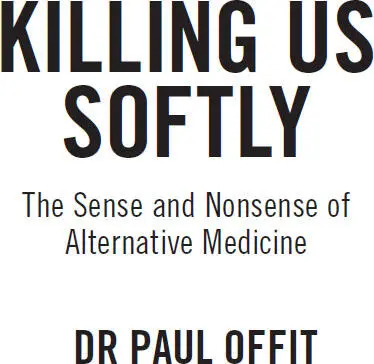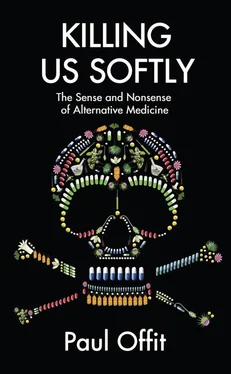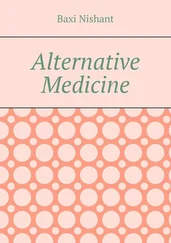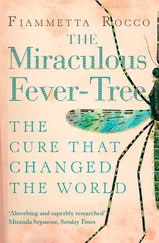

To all the science writers, science advocates, and science bloggers who have dared proclaim that the emperors of pseudoscience have no clothes
When religion was strong and science weak,
men mistook magic for medicine.
Now, when science is strong and religion weak,
men mistake medicine for magic.
—THOMAS SZASZ
Contents
Title Page
Dedication To all the science writers, science advocates, and science bloggers who have dared proclaim that the emperors of pseudoscience have no clothes
Epigraph When religion was strong and science weak, men mistook magic for medicine. Now, when science is strong and religion weak, men mistake medicine for magic. —THOMAS SZASZ
Prologue: Taking a Look at Alternative Medicine
Introduction: Saving Joey Hofbauer
Part I: Distrust of Modern Medicine
1. Rediscovering the Past: Mehmet Oz and His Superstars
Part II: The Lure of All Things Natural
2. The Vitamin Craze: Linus Pauling’s Ironic Legacy
Part III: Little Supplement Makers Versus Big Pharma
3. The Supplement Industry Gets a Free Pass: Neutering the FDA
4. Fifty-One Thousand New Supplements: Which Ones Work?
Part IV: When the Stars Shine on Alternative Medicine
5. Menopause and Aging: Suzanne Somers Weighs In
6. Autism’s Pied Piper: Jenny McCarthy’s Crusade
7. Chronic Lyme Disease: The Blumenthal Affair
Part V: The Hope Business
8. Curing Cancer: Steve Jobs, Shark Cartilage, Coffee Enemas, and More
9. Sick Children, Desperate Parents: Stanislaw Burzynski’s Urine Cure
Part VI: Charismatic Healers Are Hard to Resist
10. Magic Potions in the Twenty-First Century: Rashid Buttar and the Lure of Personality
Part VII: Why Some Alternative Therapies Really Do Work
11. The Remarkably Powerful, Highly Underrated Placebo Response
12. When Alternative Medicine Becomes Quackery
Epilogue: Albert Schweitzer and the Witch Doctor: A Parable
Notes
Selected Bibliography
Acknowledgments
About the Author
Also by Dr Paul Offit
Copyright
About the Publisher
PROLOGUE Contents Title Page Dedication To all the science writers, science advocates, and science bloggers who have dared proclaim that the emperors of pseudoscience have no clothes Epigraph When religion was strong and science weak, men mistook magic for medicine. Now, when science is strong and religion weak, men mistake medicine for magic. —THOMAS SZASZ Prologue: Taking a Look at Alternative Medicine Introduction: Saving Joey Hofbauer Part I: Distrust of Modern Medicine 1. Rediscovering the Past: Mehmet Oz and His Superstars Part II: The Lure of All Things Natural 2. The Vitamin Craze: Linus Pauling’s Ironic Legacy Part III: Little Supplement Makers Versus Big Pharma 3. The Supplement Industry Gets a Free Pass: Neutering the FDA 4. Fifty-One Thousand New Supplements: Which Ones Work? Part IV: When the Stars Shine on Alternative Medicine 5. Menopause and Aging: Suzanne Somers Weighs In 6. Autism’s Pied Piper: Jenny McCarthy’s Crusade 7. Chronic Lyme Disease: The Blumenthal Affair Part V: The Hope Business 8. Curing Cancer: Steve Jobs, Shark Cartilage, Coffee Enemas, and More 9. Sick Children, Desperate Parents: Stanislaw Burzynski’s Urine Cure Part VI: Charismatic Healers Are Hard to Resist 10. Magic Potions in the Twenty-First Century: Rashid Buttar and the Lure of Personality Part VII: Why Some Alternative Therapies Really Do Work 11. The Remarkably Powerful, Highly Underrated Placebo Response 12. When Alternative Medicine Becomes Quackery Epilogue: Albert Schweitzer and the Witch Doctor: A Parable Notes Selected Bibliography Acknowledgments About the Author Also by Dr Paul Offit Copyright About the Publisher
Taking a Look at Alternative Medicine Contents Title Page Dedication To all the science writers, science advocates, and science bloggers who have dared proclaim that the emperors of pseudoscience have no clothes Epigraph When religion was strong and science weak, men mistook magic for medicine. Now, when science is strong and religion weak, men mistake medicine for magic. —THOMAS SZASZ Prologue: Taking a Look at Alternative Medicine Introduction: Saving Joey Hofbauer Part I: Distrust of Modern Medicine 1. Rediscovering the Past: Mehmet Oz and His Superstars Part II: The Lure of All Things Natural 2. The Vitamin Craze: Linus Pauling’s Ironic Legacy Part III: Little Supplement Makers Versus Big Pharma 3. The Supplement Industry Gets a Free Pass: Neutering the FDA 4. Fifty-One Thousand New Supplements: Which Ones Work? Part IV: When the Stars Shine on Alternative Medicine 5. Menopause and Aging: Suzanne Somers Weighs In 6. Autism’s Pied Piper: Jenny McCarthy’s Crusade 7. Chronic Lyme Disease: The Blumenthal Affair Part V: The Hope Business 8. Curing Cancer: Steve Jobs, Shark Cartilage, Coffee Enemas, and More 9. Sick Children, Desperate Parents: Stanislaw Burzynski’s Urine Cure Part VI: Charismatic Healers Are Hard to Resist 10. Magic Potions in the Twenty-First Century: Rashid Buttar and the Lure of Personality Part VII: Why Some Alternative Therapies Really Do Work 11. The Remarkably Powerful, Highly Underrated Placebo Response 12. When Alternative Medicine Becomes Quackery Epilogue: Albert Schweitzer and the Witch Doctor: A Parable Notes Selected Bibliography Acknowledgments About the Author Also by Dr Paul Offit Copyright About the Publisher
People love alternative medicine. They go to their acupuncturist or chiropractor or naturopath to relieve pain. They take ginkgo for memory or homeopathic remedies for the flu or megavitamins for energy or Chinese herbs for potency or Indian spices to boost their immune systems. Fifty percent of Americans use some form of alternative medicine; 10 percent use it on their children. It’s a $34-billion-a-year business. In the EU, alternative remedies are also popular; more than 100 million people use them. My friends are no different. One uses cold laser therapy for his allergies, another takes a homeopathic remedy named oscillococcinum to cure her colds, and a third swears that acupuncture is the only thing that relieves his back pain.
Furthermore, alternative medicine—which in the 1960s was denigrated as fringe or unconventional medicine—has entered the mainstream. Hospitals have dietary supplements on their formularies or offer Reiki masters to cancer patients or teach medical students how to manipulate healing energies. In 2010, a survey of six thousand hospitals found that 42 percent offered some form of alternative therapies. When asked why, almost all responded, “patient demand.” In the United Kingdom, five homeopathic hospitals work within the National Health Service. Big Pharma is also jumping in. On February 27, 2012, Pfizer acquired Alacer Corporation, one of the country’s largest manufacturers of megavitamins.
The reason alternative therapies are popular is simple. Mainstream doctors are perceived as uncaring and dictatorial, offering unnatural remedies with intolerable side effects. Alternative healers, on the other hand, provide natural remedies instead of artificial ones, comfort instead of distance, and individual attention instead of take-a-number-and-wait-your-turn inattention.
Читать дальше



![Джейн Остин - Sense and Sensibility [С англо-русским словарем]](/books/26612/dzhejn-ostin-sense-and-sensibility-s-anglo-thumb.webp)
![Edzard Ernst - Trick or Treatment. The Undeniable Facts about Alternative Medicine [Electronic book text]](/books/151762/edzard-ernst-trick-or-treatment-the-undeniable-fa-thumb.webp)









